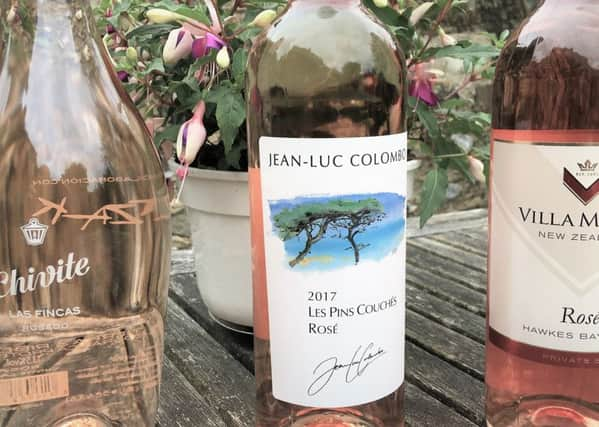RICHARD ESLING: Everything's coming up rosés


So far, for England, we can’t complain too much. Most of the frost problems were avoided in April, May was the warmest since records began and June so far has been agreeably warm and sunny, albeit with the odd flood thrown in here and there.
So, it’s time to be drinking something cool and refreshing WineWyse and some of the most versatile wines for summer drinking are those that are various shades of pink – the rosés.
Advertisement
Hide AdAdvertisement
Hide AdIncredibly popular in France, there seem to be mixed opinions among us Brits, some loving them and others being somewhat indifferent. The indifference may at times stem from a lack of understanding of just what this type of wine is all about. Rather than being a halfway-house between white and red, rosé is a distinct and individual style of wine and a good, characterful rosé is difficult to produce.
Although rosé may be made in some countries of the New World by blending red and white wines, in Europe this is banned, except in one region – that of champagne. Here, some producers make pink champagne by blending a little red wine into white, which is perfectly authorised and when carefully controlled by the winemaker, can produce excellent, high quality wines. But in the rest of Europe, rosé is made from red grapes, the skins that give the colour, being left in the fermentation vat for a short time to give just the required amount of colour.
When I say “short time”, it can be as little as a couple of hours. Herein lies the challenge for the winemaker – how to get sufficient flavour, aroma and body into the wine and yet keep the colour pale. Currently, the fashion is for rosé wines to be very pale indeed, yet with an experienced winemaker, they can be aromatic, flavoursome and refreshing. I find pale rosés attractive and appealing, exuding a certain summer elegance. Naturally, the pale colour needs to be backed up by full fruit flavours and aromas and for me, a dry finish. The versatility comes in with the many occasions for which rosé is suitable and the different dishes with which it can be paired.
Sipped in the garden at lunchtime, on the terrace in the evening, for picnics or dinner parties, well-made dry rosé is perfect and can accompany starters, vegetable dishes, fish, poultry and meat. Two tips on buying rose – find the youngest vintage you can, 2017 if possible although 2016 should still be OK and buy it pale – more difficult to make and thus normally from a good winemaker.
Advertisement
Hide AdAdvertisement
Hide AdProvence, in the South of France has to be the world number one region for well-made, dry, rosé wines, with several appellations producing delicious, fruity examples, including Cotes de Provence, Coteaux d’Aix en Provence, Bandol and several regional designations (IGP – Indication Geographique Protegée). Alternatively, there are some great pale rosés from other parts of France and other countries of Europe and the world. From the southern Rhone valley comes a pale pink, elegant wine made by a top producer – Jean-Luc Colombo. Made from a blend of Syrah and Mourvedre, it has spicy red fruit flavours and is dry and refreshing. Perfect with grilled sardines.
On the other side of the globe, the top New Zealand wine producer Villa Maria has a deliciously fruity and full-flavoured pink from Hawkes Bay. Look out for the The Private Bin 2017 arriving on the shelves of Asda this month (£10.75). Well balanced with a dry finish and great with smoked salmon and seafood.
But one of the stars outside France has to be the Chivite Las Fincas Rosé 2017, voted the best Rosé of Spain by a panel of top critics. Coming from the Navarra region of Spain in the Tierra 3 Riberas, it is made with a blend of Garnacha and Tempranillo grapes. Modern wine-making with maceration, long, cool fermentation and ageing on the lees, has produced an exceptional dry wine, with surprising fruit aromas and depth of flavour for a very, very pale coloured wine. Elegant, smooth, delicate and delicious. (Great Western Wine Company £14.95 per bottle).
Richard Esling BSc DipWSET is an experienced wine consultant, agent, writer and educator. An erstwhile wine importer, he runs a wine agency and consultancy company called WineWyse, is founder and principal of the Sussex Wine Academy, chairman of Arundel Wine Society and is an International Wine Judge. Twitter @richardwje. Visit www.winewyse.com.
Advertisement
Hide AdAdvertisement
Hide AdDon’t miss out on all the latest breaking news where you live.
Here are four ways you can be sure you’ll be among the first to know what’s going on.
1 Make our website your homepage
2 Like our Facebook page
3 Follow us on Twitter
4 Register with us by clicking on ‘sign in’ (top right corner). You can then receive our daily newsletter AND add your point of view to stories that you read here.
And do share with your family and friends – so they don’t miss out!
Be part of it.